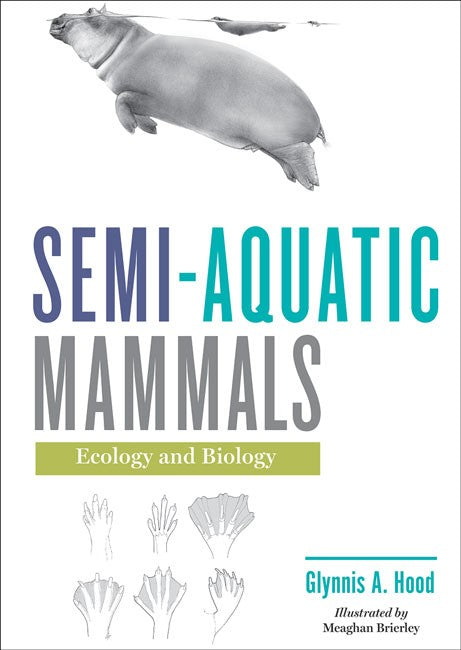1. IntroductionWhat is a semi-aquatic mammal?The semi-aquatic mammals: The monotremes: The marsupials: The EutheriansFreshwater habitatsPART I: GEOGRAPHICAL DISTRIBUTION AND HABITATS2. PALEOBIOLOGYPaleobiologyExtinct mammal-like semi-aquatic taxaExtinct mammalian ordersPaleobiology of extant orders: Order Monotremata (monotremes): Order Didelphimorphia (American marsupials): Order Afrosoricida (tenrecs and elephants): Order Proboscidea (elephants and extinct relatives): Order Lagomorpha (pikas, hares, and rabbits): Order Rodentia (rodents): Order Eulipotyphla (true shrews, desmans, and shrew-like moles): Order Carnivora: Order Artiodactyla (even-toed ungulates): Infraorder Cetacea (whales and relatives)3. RANGING ACROSS THE CONTINENTSIntroduction to distributionsTypes of distributions and whyDistributions across broad zoogeographic realms: Afrotropical: Australian: Madagascan: Nearctic: Neotropical: Oceanian: Oriental: Palearctic: Panamanian: Sahara-Arabian: Sino-Japanese4. ECOLOGICAL NICHESEcological nicheSpecies interactionsSpecies as engineers: Burrows, channels, and trails: Lodges and nestsSpecial environments: Beavers: MuskratTemporal niche partitioningPART II: PHYSICAL ADAPTATIONS5. MORPHOLOGYMorphological adaptationsBody mass and shapeIntegumentary system: Skin: Interdigital webbing: Fat: Hair: Exocrine glands: Claws, nails, and hooves: Nerves and sensory organsAxial and appendicular skeletonMuscle6. PHYSIOLOGICAL ADAPTATIONSWater as a mediumBasic physiology of semi-aquatic mammals: Temperature regulation: Body size: Metabolism: Regional heterothermy: Thermogenesis: Oxygen exchange and energetics: Energy intake and digestionNeurobiology7. LOCOMOTION AND BUOYANCYMoving through waterGeneral physical characteristics: Limb and tail modificationsBuoyancy and stabilitySwimming modes8. THE PREDATORSTypes of predationForaging strategies: Foraging theory: Caching and hoardingForaging nichesCarnivorous mammals: Carnivores: Crustacivore/clam-eater: Insectivore/omnivores: Piscivore/squid-eaterHerbivores: Herbivore/browser: Herbivore/grazer: Herbivore/frugivore: Frugivore/granivore: Frugivore/omnivore9. THE PREYNATURE OF PREDATIONOther forms of predation: Microparasites: MacroparasitesPredator detection and avoidance: Detection: Chemical: BehaviourSurviving predation: Intimidation: Flight: Fighting backPART IV: REPRODUCTION10. MATING AND OFFSPRINGReproductive biologyMating systemsSociality: Group living and associated breeding strategies: Solitary behavior: Delayed implantation: Parental care: Reproduction and conservationPART V: CONSERVATION CHALLENGES AND MANAGEMENT APPROACHES11. STATUS AND THREATSConservation: A backgroundStatus and trends: Extinct and Extinct in Wild category: Critically Endangered category: Endangered category: Vulnerable category: Near Threatened category: Least Concern category: Data Deficient category: Not evaluated categoryThreats: Human population growth: Habitat loss: Habitat degradation: Over-exploitation: Cultural perceptions of wildlife: Climate change: Synergistic effects: Future directions12. INTRODUCTIONS AND REINTRODUCTIONSTranslocationsIntroductions: North American beaver: Coypu: Muskrat: American minkReintroductions and assisted colonization: Platypus: Swamp rabbit: Marsh rabbit: North American beaver: Eurasian beaver: Russian desman: European mink: Eurasian otter: North American river otter: Marsh deer: Père David's deerConservation considerations13. MANAGEMENT APPROACHESPopulation recoveryHabitat protection and enhancement: Protected area management and aquatic connectivity: Freshwater and riparian habitat conservation and restoration: Invasive species managementEx-situ conservationResearch and monitoring: Emerging approachesLegal protections and enforcementWildlife conservation organizationsFuture considerationsAPPENDIXGLOSSARYREFERENCESINDEXABOUT THE AUTHOR AND ILLUSTRATOR

